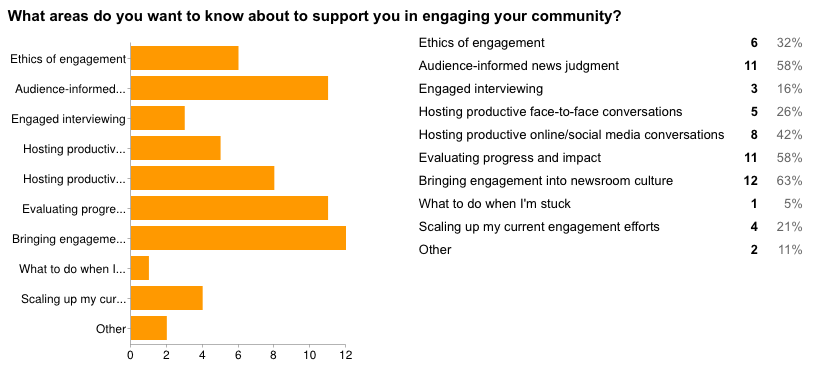By Jacob Caggiano
For journalism to evolve, community engagement is key.
The news cycle is no longer controlled by the industry. They may still break stories, but the public sets the tone and decides how long, how deep, and how intensely we talk about our most pressing issues.
We are working to define essential skills and cultural norms for community engagement, which frankly, is a huge task…
In order to find focus and hone our strategy, we sent out a survey to our partners at the American Society of News Editors, as well our unconference alumni at Journalism That Matters.
Our first round brought 19 responses. We will leave the survey open until the end of September so take a moment to lend your voice. Here’s some interesting info gathered so far:

Communities of color need better representation
While the latest ASNE census showed an increase in diversity among working journalists, it is still a recognized problem, as the percentage of white reporters creating the news is well above the percentage of white people who live in the communities they are covering.
When asked: “What types of communities do you want to engage with more?” half our respondents indicated that they want to engage more with communities of color. Our three pilot sites, We Create Here – The Gazette, Cedar Rapids, Iowa, Unite Rochester – Democrat and Chronicle, Rochester, New York, and Oakland Voices – The Oakland Tribune, Oakland, California are examples of news organizations doing just that. We continue to seek other stories.
Note: if you have examples to share, please tell us your story!
Young people are elusive
Tied in second place for the same question are millennials (born between 1980 to 1995), who are especially hard to reach for news editors and academics.
There are some good tips available, notably this video from Knight journalism fellow, Tran Ha, though plenty more to learn when it comes to reaching a generation hooked on Snapchat.

We need to grow our audience and engage with locals who don’t read our content
It’s no secret that print subscriptions have plummeted, and many people rely on manipulated algorithms based on social taste to get their primary news fix.
This checkbox got the most hits, at 63%, and was often coupled with a desire to reach “people who feel disenfranchised or powerless.” It would be great to see more newsrooms engaging the way St. Louis Public Radio did during the unrest in Ferguson, MO.
Newsroom culture needs a push
63% of respondents want more support in bringing engagement into newsroom culture.
A lot of folks also want support for better “audience-informed news judgment” – where story decisions can come directly from the needs that the community brings forward. The Gazette Company in Cedar Rapids, Iowa did just that in order to address the need for more affordable housing.
Good evaluation techniques are important
58% of respondents want support “evaluating progress and impact.” There are lots of resources out there, the Media Impact Project is a good place to start, or anything by Joy Mayer.
It’s also worth noting that 42% want help “hosting productive online/social media conversations” – which is really essential to figure out in order to do a proper impact analysis. This guide from Howard Reingold and this one from The World Cafe come to mind as good places to brush up.
Some helpful comments we received
I’m continually looking for ways to, as a journalist, be a facilitator of conversation and growth without having to be the host — without giving the impression that I think I’m starting the conversation. I want to join and help community conversations — going where people are talking, not just expecting them to come to us.
How to create digital engagement culture so welcoming and safe that people will comment and otherwise engage even though they do so no where else.
I’m interested in the best ways to breach the digital divide which leaves those in the lower socio-economic sectors without access to the internet and social media.
Thank you too all who have responded so far. We’re leaving the survey open until the end of September and would love to hear from you.
